History of the FernUniversität
How it All Started
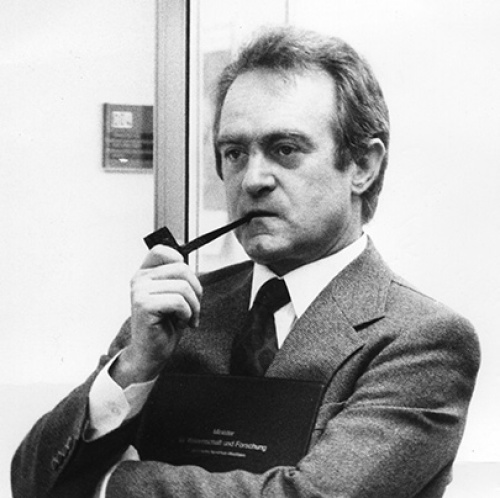 Photo: FernUniversität
Photo: FernUniversität
There could not have been a better time to found a distance learning university in Germany than the mid-1970s: rising student numbers threatened existing universities with overcrowding and there were calls to implement new didactic methods as part of higher education reform.
At the same time, structural changes to the German economy increased demand for highly-qualified personnel, but there were few options for university-level continuing education. Student organizations campaigned for increased use of technology and multimedia in teaching, increased student participation, and distance learning options.
In response to these conditions, North Rhine-Westphalia’s Minister of Science Johannes Rau laid out a plan for a distance learning university which would be based in the state of North Rhine-Westphalia, but active throughout Germany. This plan was approved by the state’s government on October 9, 1973, setting the stage for a unique success story within the German educational system.
Establishing the FernUniversität
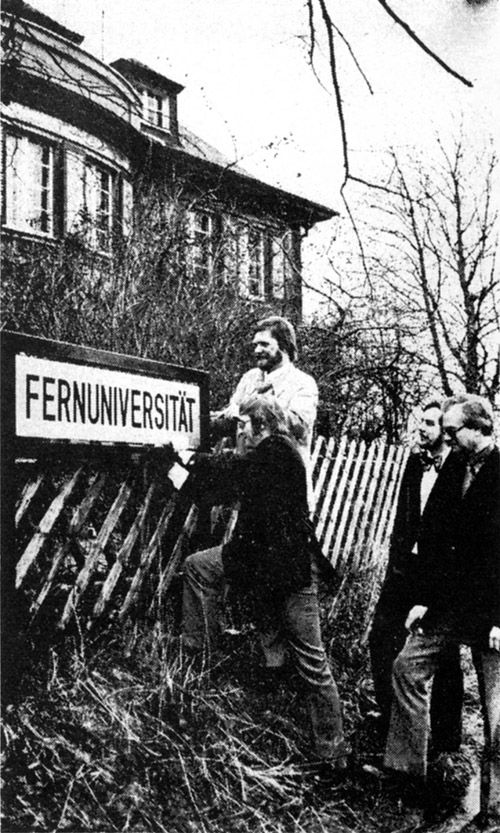 Photo: FernUniversität
Photo: FernUniversität
A committee of experts consisting of researchers and university instructors assembled to design the distance learning system of this new university. To ensure a high quality of teaching, their plan included printed study materials, audio and visual media, and regular monitoring of students’ progress, which would be supplemented through in-person advising and teaching in local study centers. Among the committee members was Prof. Otto Peters, a distance learning expert who would become the FernUniversität's founding president.
The FernUniversität officially came into being on December 1, 1974. It was headquartered in the Villa Bechem, which today is part of the FernUniversität’s campus, while other offices were scattered in rented rooms throughout Hagen.
In addition to academic departments for educational science, business administration and economics, and mathematics, the FernUniversität quickly established centers for research and development in distance learning to support its teaching staff and guide the development of its distance learning system.
Teaching at the FernUniversität began in October 1975, when the first printed study materials were shipped to around 1,330 students who enrolled for the first semester. At the same time, the FernUniversität’s first 13 study centers in North Rhine-Westphalia began operations and provided local support for distance learning students. Today, in addition to regional and study centers spread throughout Germany, the FernUniversität offers in-person support in Austria, Hungary, and Switzerland.
Rapid Growth
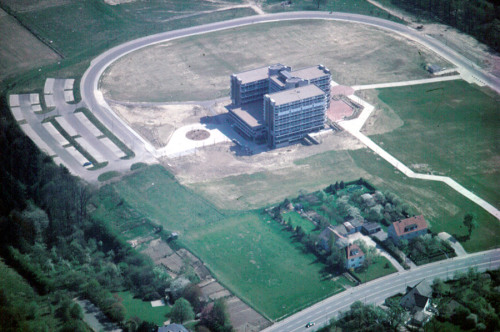 Photo: FernUniversität
Photo: FernUniversität
In its first years, the FernUniversität grew quickly, with its student body more than doubling to over 5,000 students by the second year. Within five years, it had grown to over 22,000 students and by 1986 the student body exceeded 30,000 students.
In particular, the FernUniversität created attractive new options for students who were already in regular employment to study alongside their careers. It was also among the first universities in Germany to enable access to higher education for students without traditional university entrance qualifications.
With this rapid growth came construction of the first building of the FernUniversität's campus, which began in 1976. Since this first building, completed in 1980, the campus has grown steadily along with the FernUniversität and today consists of eleven buildings, including a cafeteria and the MiniCampus childcare center.
Its distance learning model evolved along with it. In October 1979, the FernUniversität reached a milestone when its first central computer began operations, and a network node was established. For the first time, students had online access to the FernUniversität via other university computer centers.
In 1990, the FernUniversität’s logistics team had also passed a major milestone, with over 44 million items sent since beginning operations, including printed study materials, multimedia cassettes, assignments, exams, and answer keys. By the mid-1990s, the FernUniversität’s logistics team averaged 8,000 shipments per day, and the FernUniversität established a state-of-the-art logistics center in 1993 to meet this demand.
New Technology for Flexible Learning
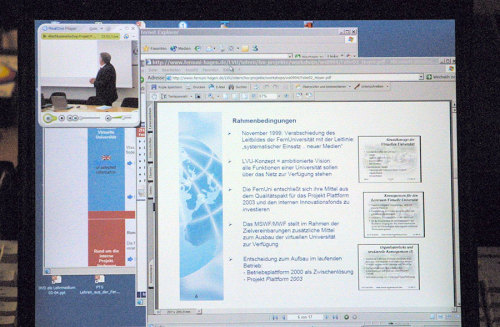 Photo: FernUniversität
Photo: FernUniversität
At the same time that it achieved this logistics milestone, the FernUniversität was further developing its distance learning model on the basis of new technologies. In 1990, the FernUniversität hosted the International Conference on Computer-Assisted Learning, one of the world’s largest conferences on the subject, reflecting its increasing importance as an innovator in technology-supported education.
By 1994 the FernUniversität’s first web server went into operation, and it implemented its Virtual University Learning Environment project, a major digitalization effort aimed at making student services, advising, teaching and research activities available online, while continuing to supplement these with printed study materials and in-person teaching and events.
Further developments in the following years included implementation of online video exams and an online library catalog, giving FernUniversität students further flexibility in terms of location.
These advances placed the FernUniversität at the forefront of internet-supported distance learning within Germany and are central elements of the FernUniversität’s blended learning model, which is characterized by the combination of a wide variety of online and printed materials with in-person teaching.
First Online Degree Program
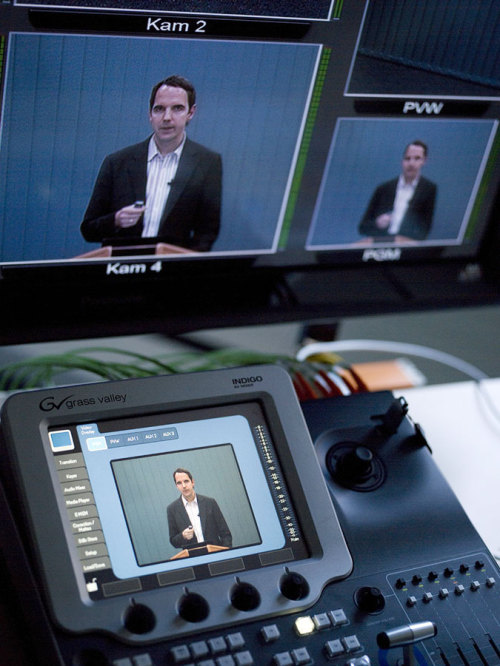 Photo: FernUniversität
Photo: FernUniversität
By the winter semester in 1999/2000, the FernUniversität’s Bachelor in Computer Science became its first degree program which could be completed entirely online through the Virtual University Learning environment.
The options for digitally-supported learning further increased in 2002, when the FernUniversität’s first video lecture was transmitted online. Today, such online lectures are an integral part of the FernUniversität’s distance learning system, in combination with printed study materials, in-person learning and a wide spectrum of digital tools, ranging from the Moodle online learning platform, to digital seminar rooms, to online library resources.
In order to support and continuously develop its digital learning programs, in 2005 the FernUniversität consolidated its former computing center, its center for distance learning development and the Virtual University Learning Environment project into the new Center for Media and IT, which provides specialist support and customized solutions for the technical needs of the FernUniversität’s distance learning system.
Germany's Largest University
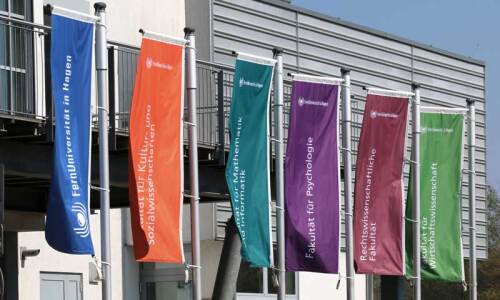 Photo: FernUniversität
Photo: FernUniversität
Structural changes at the FernUniversität in 2004 led to the reorganization of the FernUniversität’s academic departments into four faculties: the Faculty of Humanities and Social Sciences, the Faculty of Business Administration and Economics, the Faculty of Mathematics and Computer Science, and the Faculty of Law. In 2018, this would be followed by the establishment of Psychology as its own faculty, separate from the Faculty of Humanities and Social Sciences, leading to today's structure in five faculties.
By 2008, the FernUniversität had become Germany’s largest university in terms of student numbers, with over 43,000 students. It retains that title today, but its student body has since grown to nearly 77,000.
As its largest university, the FernUniversität has continued in its role as an innovator in the German higher education system, finding new ways of engaging with students and society through technology. Through social media, MOOCs, study-buddy matching apps and other methods, it makes use of a wide variety of means to connect and engage students at a distance.
At the same time, it maintains close ties with its local community in Hagen through events like its “Hagener Kontroverse” (“Hagen Controversies”) and “Hagener Forschungsdialog” (“Hagen Research Dialogue”) event series and its yearly campus festival. These local ties were recognized in 2012 when the city of Hagen officially designated itself the “City of the FernUniversität.”
A University for the Future
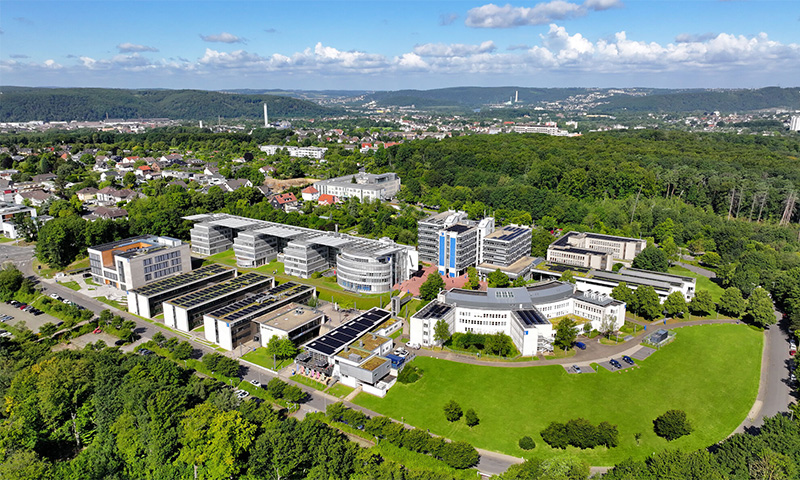 Photo: Markus Kecker
Photo: Markus Kecker
In recent years, the FernUniversität has continuously adapted itself to meet the challenges and needs of a changing world, focusing on providing necessary solutions for an increasingly global and digital future.
In research, this has resulted in the formation of three interdisciplinary research clusters that address current areas of societal change via interdisciplinary approaches. The first of these, the Digitalization, Diversity, and Lifelong Learning: Consequences for Higher Education research cluster, was founded in 2017, and focuses on upcoming challenges for higher education institutions based on the technological and social changes brought about by digitalization. This was followed by the Energy, Environment, and Sustainability research cluster, which addresses the political, economic, social and technological aspects of its three central topics, and the digital_culture cluster, which analyses changes to the culture brought about by digitalization.
As it continues to pioneer new approaches in distance education and to address new challenges for education in a changing world, the FernUniversität builds on its strong foundation of over 40 years of experience in developing higher education solutions with the flexibility to meet the needs of the future.
More FernUniversität History
Want to learn more about the FernUniversität's history? On our German-language site, you can view a detailed interactive timeline, watch video interviews with the people who witnessed and shaped the FernUniversität's history, and more.

